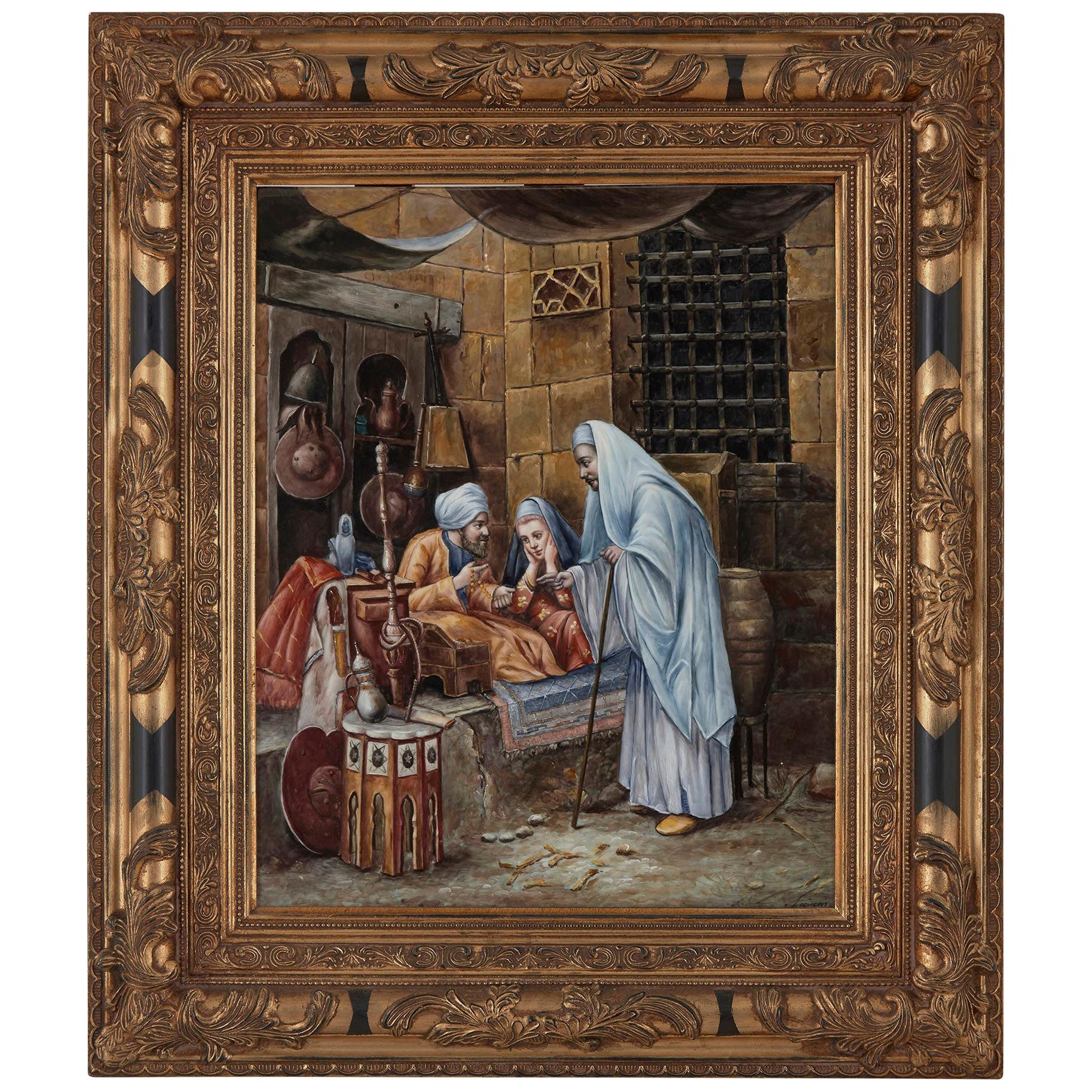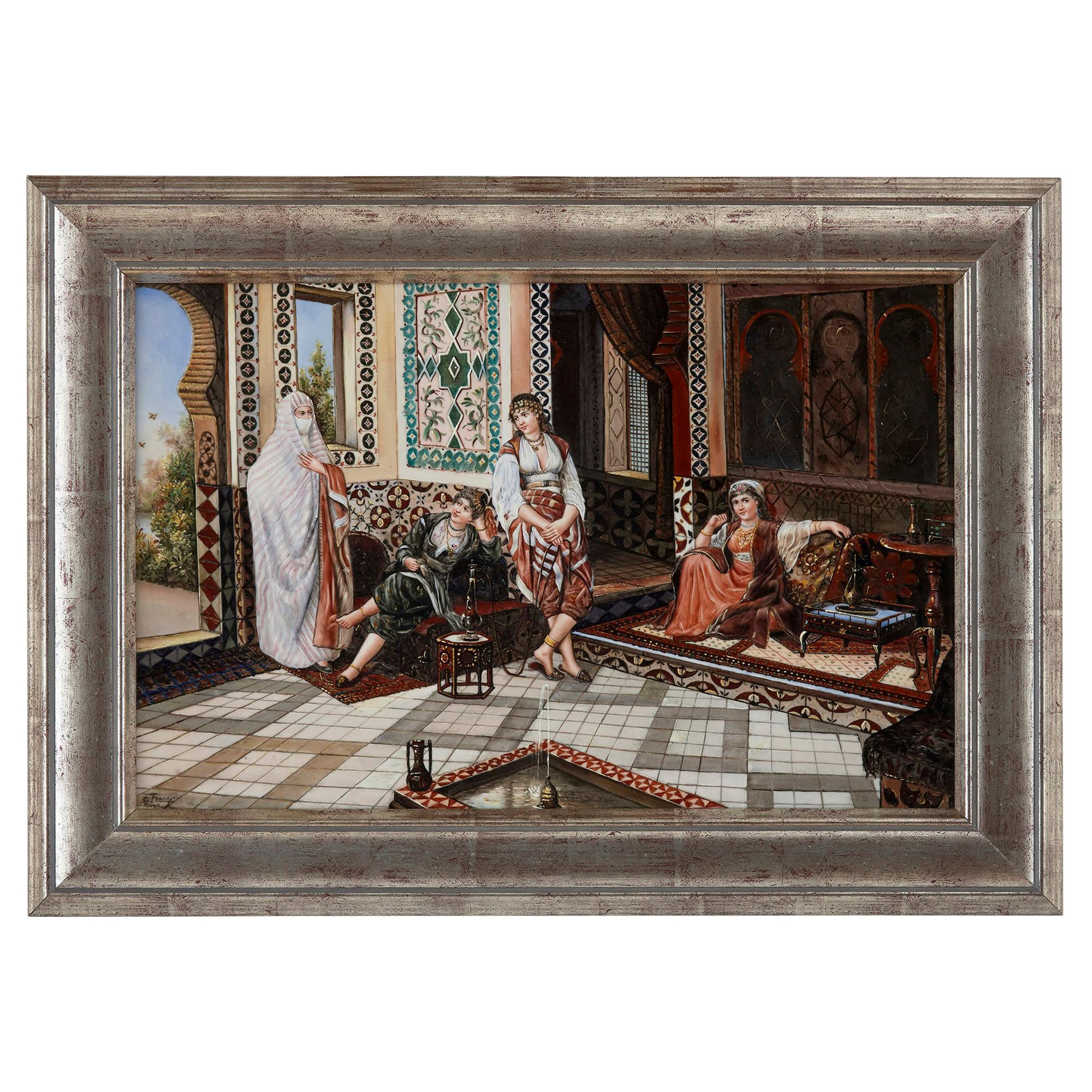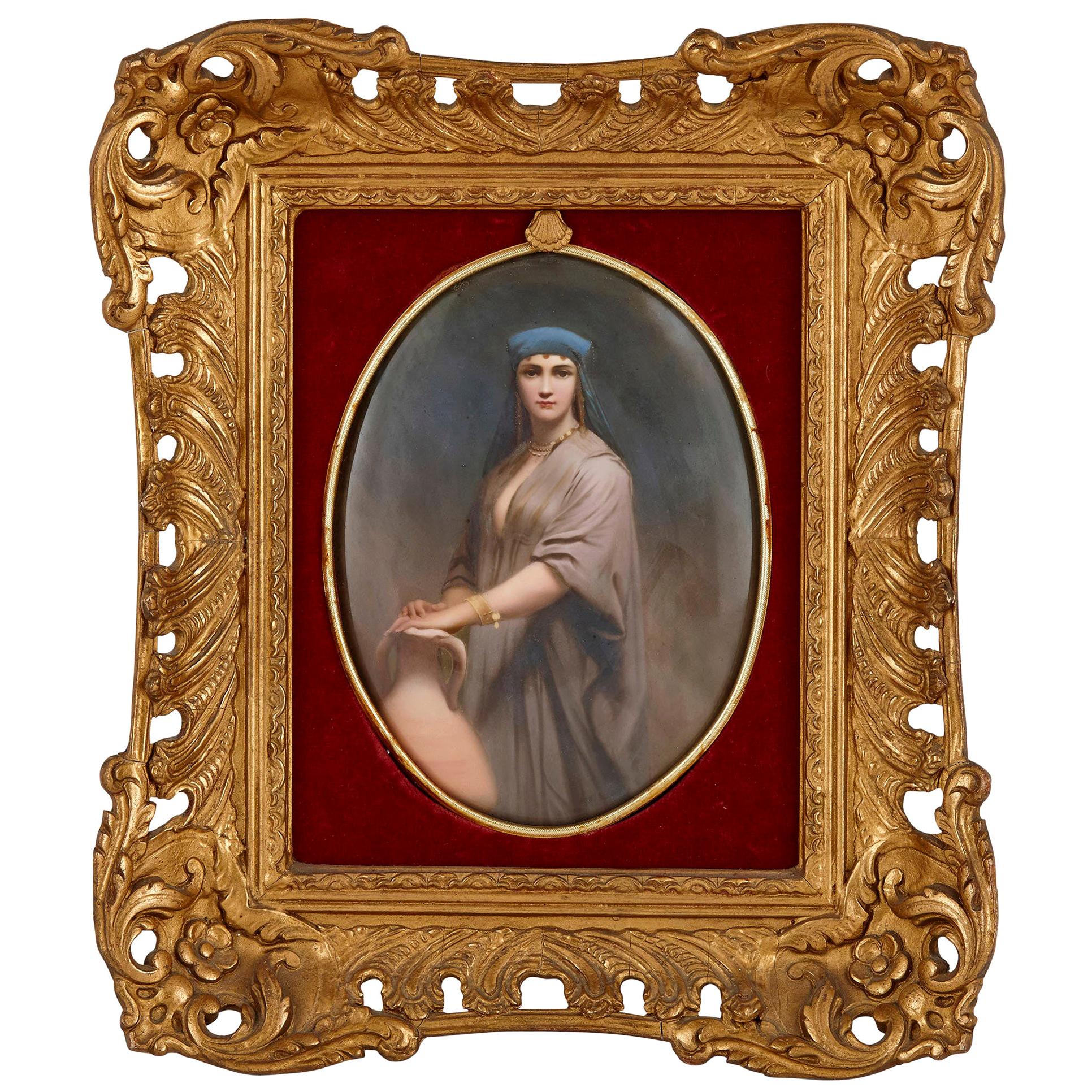Items Similar to A French Napoleon III Large Pair of Orientalist Porcelain Plaques, 1908
Want more images or videos?
Request additional images or videos from the seller
1 of 15
A French Napoleon III Large Pair of Orientalist Porcelain Plaques, 1908
About the Item
A French Napoléon III Large Pair of very decorative hand-painted polychromed Porcelain Plaques with Orientalist scenes, with traditional costumed characters.
In the manner of Rudolf Ernst (1854-1932), the famous Orientalist painter:
One Representing “Le marchand d’oranges”, the Oranges merchant, the other one “Le fumeur de Narguilé”, the hookah smoker.
Both signed L.Lagrange, one dated 1908 and located Dijon
In originals wooden frames
Napoléon III Period
Plaque dimensions H 43 cm L 33 cm
Total dimensions H 57,5 cm L 48 cm
Rudolf Ernst (1854, Vienna-1952, Fontenay-aux-Roses, France)
Best known for Ottoman Empire paintings of elaborately costumed merchants, guards or sentinels and pashas as well as a few portraits from his 1890 travels in Turkey, Rudolf Ernst was a leader of the second generation of the Orientalist movement and the leader of the movement in his native country of Austria. Initially the movement had been focused on life-changing political events such as the liberation of Greece and Napoleon's march through Algeria. The second generation of painters such as Ernst and his friend, Ludwig Deutsch, were more interested in daily life genre scenes or static figures 'keeping the peace'.
Because of his use of photography on his travels through Moorish Spain, Morocco, Tunis Constantinople and Egypt, he had detailed records, now of historical value, for the clothing and settings he depicted for his subjects. On these trips he became especially mindful of dec-oration styles, especially tile making. Among the titles of his paintings are: Harem Guard, The Arab Prince, The Moorish Guard and Elegant Arab Ladies on a Terrace at Sunset.
Rudolf Ernst was born in Vienna, the son of Leopold Ernst, a painter. In 1869, at age 15, he joined the Academy of Fine Arts in Vienna, and five years later went to Rome to study Italian landscape and classical figure painting. In 1876, he moved to Paris and began sixty years of exhibiting his paintings at the Salon des Artistes Francais. In 1877, he had his first exhibit at the Hall of French Artists. At that time, he also began the life-long friendship he had with Ludwig Deutsch, and he eventually became a French citizen.
The next several decades beginning with the 1880s were quite productive for Ernst. Having begun working in the Orientalist manner in 1885, between that year and 1896, he completed four major paintings: The Messanger, (1885) Prayer in the Mosque (1888), Arab Smoking a Waterpipe on a Sofa (1894) and Return from the Tiger Hunt (1896). He also won a bronze medal in the Exposition Universelle in 1889, and in 1890, traveled to Turkey and Egypt.
In 1900, he became a resident of Fontenay-aux-Roses, France, and lived a quiet and some-what reclusive life away from Paris. Living in a home he decorated in Ottoman style, he continued to be productive, completing at least 20 large-scale Orientalist-theme paintings. In fact, he was so committed to his subject matter that he wore a "tarboosh", the tasseled cap well known to the people he depicted.
Rudolf Ernst died in 1932 at this home in Fontenay-aux-Roses.
- Similar to:Rudolf Ernst (Painter)
- Dimensions:Height: 18.9 in (48 cm)Width: 22.64 in (57.5 cm)Depth: 0.79 in (2 cm)
- Sold As:Set of 2
- Style:Napoleon III (Of the Period)
- Materials and Techniques:
- Place of Origin:
- Period:1900-1909
- Date of Manufacture:1909
- Condition:Wear consistent with age and use.
- Seller Location:Saint-Ouen, FR
- Reference Number:1stDibs: LU2612339307242
About the Seller
4.9
Vetted Seller
These experienced sellers undergo a comprehensive evaluation by our team of in-house experts.
1stDibs seller since 2017
56 sales on 1stDibs
Typical response time: 1 hour
- ShippingRetrieving quote...Ships From: Saint-Ouen, France
- Return PolicyA return for this item may be initiated within 2 days of delivery.
More From This SellerView All
- Pair of French Napoléon III Curule ArmchairsLocated in Saint-Ouen, FRPair of French Napoléon III Curule Armchairs Moulded, carved, blackened wood, enhanced with gold. Open-banded back decorated with interlacing, X-bas...Category
Antique 1890s French Napoleon III Armchairs
MaterialsWood, Trimming
- French Pair of Napoleon III Ormolu Wall-Lights after Jean-Charles DelafosseBy Jean-Charles DelafosseLocated in Saint-Ouen, FR19th Century French Pair of chiseled and gilded bronze wall-lights, the fluted barrel, from which acanthus leaves escape in scrolls forming two arms of light, and crowned with a fire pot, neck-shovels with twisted flutes, heart, hoes with leaves of water. Circa 1880 Parisian quality work of the late nineteenth century after a model by Jean-Charles Delafosse (1734-1791), famous french architect, ornamentist and painter. Original gilding Electrified H 40 cm L 36 cm P 20 cm The model of our sconces takes the creations of 18th century bronzers who were directly inspired by the drawings of Jean-Charles Delafosse in the 1760s. In particular, the collection of engravings...Category
Antique 1880s French Louis XVI Wall Lights and Sconces
MaterialsOrmolu
- French 19th Century Pair of Porcelain Cache-PotsLocated in Saint-Ouen, FRPair of polychromed hand painted porcelain with Japonisme floral decoration Ormolu-mounted with open-worked base and rim Louis XVI Style circa 1880.Category
Antique 1870s French Chinoiserie Planters, Cachepots and Jardinières
MaterialsOrmolu
- A French Napoléon III Ormolu Cartel Clock by Susse Frères Paris circa 1870By Susse FreresLocated in Saint-Ouen, FRA French 19th Century Cornucopia Gilt-Bronze Cartel, by Susse Frères Paris An Ormolu Cartel in the shape of an escutcheon, with a circular white enamel dial, signed Susse Frères/A Paris, Arabic numerals for the hours and for the minutes. It's bordered by a frieze of pearls and surmounted by a falling laurel knot with a drapery in the lower part and flanked by cornucopias adorned with flowers and fruits. Rectangular base decorated with a garland of knotted flowers dying in a tapered, fluted barrel and damping, in the upper part, a flowery Medici vase. Louis XVI Style Circa 1870 Original gilding uncleaned The Susse company, a worldwide reknown foundry, began to cast pieces as soon as the first half of the 19th Century. Awarded medals...Category
Antique 1860s French Louis XVI Wall Clocks
MaterialsOrmolu
- A French 19th Century Pair of Louis XVI Style Large Curule StoolsBy Georges Jacob, Maison JansenLocated in Saint-Ouen, FRA French 19th Century Pair of Large Rectangular Curule Stools Gilt and carved wood, decorated with interlace frieze, acanthus leaves and rosaces The 4 feet linked by a gadrooned stretcher. Louis XVI Style Napoléon III Period In the manner of Georges Jacob (1739-1814) Attributed to Maison Jansen Circa 1900 Used Petit Point Tapestry Upholstery Maison Jansen, the French luxury: Opulence, refinement, audacity of style marriages… so many words agree with Maison Jansen. Through this name, a whole era sounds like a reminder of a certain French chic… Some names evoke immutable images, atmospheres... Like Jansen, for example. Let’s close our eyes… The 1960s and 1970s are at their peak. France is doing well. It is a country of full employment where everything seems possible. Within the international Jet Set, a carefree crowd of movie stars, public figures, literary idols and crowned heads, we love the Maison Jansen, its taste for styles struck with a good quality exuberance, and its brilliant side. It all began in 1880, when the Dutchman Jean Henri Jansen founded the epon-ymous house in Paris. Jansen is part of the continuity of these world-famous furniture manufacturers and companies that operated under the Second Empire and at the time of the Universal Exhibitions, as the ‘Escalier de Cristal’ teaches. At that time, the Union Centrale des Beaux-Arts appliqués à l'Indus-trie and the Société du musée des Arts Décoratifs merged to form the Union Centrale des Arts Décoratifs. Supported by both gallery owners, collectors and manufacturers, this organi-zation gives the «la» to the whole profession, and in the prevailing politico-ideological slump (France was defeated by Prussia in 1871 and Napoleon III is in exile), the ‘Union Centrale des Art Décoratifs’ focuses production on the celebration of past styles. While this nostalgia evokes memories of an era that we imagine more stable, an innovative exoticism will be all the rage: the reign of Turkish style and Japonisme. The Jansen house masterfully rushed into the «exotic» trend, but quickly de-veloped a style derived from the ornamental splendor of the eighteenth, then a little later, so-called «imperial» styles mainly intended for royal families. Af-ter the First World War, J.H Jansen was joined by the cartoonist Albert Cazes, by Stéphane Boudin and by Pierre Delbée, who successively directed the house when it disappeared in 1929. At the end of the Kennedy era, Boudin complete-ly redecorated the White House, at the request of the First Lady, Jackie, who had fallen in love with his work after discovering it at Malmaison. In 1971, Jansen joined forces with Leleu-Deshays and continued its quest for excellence. From 1969 to 1979, the dandy decorator Serge Robin took the reins of the house, granting it an eclectic and luxurious style: he revisited the great eras of French art, from the Renaissance to Louis XVI, by modernizing them with more contemporary pieces in Plexiglas or wrought iron. His recomposed and sophisticated style met with resounding success. When Jackie Kennedy, who became the wife of the great Greek shipowner Aristotle Onassis, moved to France, the young architect married Louis XVI-style furniture to modernist designs from the 1950s. When the Shah of Iran decided to celebrate the 250th anniversary of the Per-sian Empire in 1971, Serge Robin and his teams turned to the grandiose and ephemeral setting of Persepolis. A hundred semi-trailers then left the work-shops on Rue Saint-Sabin to reach Tehran. At the same time, Princess Soraya of Iran commissioned her a sumptuous palace for Avenue Montaigne, the princes Faisal bin Fahd of Arabia and Mubarak Al-Sabah, and the Agnelli snatched it. On the French side, he puts his talent at the service of Brigitte Bardot, for whom he completely revamped the Madrague and the Lannes boulevard. Serge Robin embodies all the audacity of the name Jansen with the most im-probable weddings. With him, Plexiglas tables, Japanese chairs from the 50s, gold thread curtains, zebra sofas...Category
Antique 1890s French Louis XVI Stools
MaterialsTapestry, Wood, Giltwood
- "Ce qu'évoquent les Livres" by Émile Aubry '1880-1964'By Louis AubryLocated in Saint-Ouen, FR"Ce qu'évoquent les Livres" Allegory of the Literature Oil on canvas Signed on the lower part beside parchment 111 x 133 x 2 cm Framed 125 x 146 x 7 cm Provenance: Collection Georges AUBRY, brother of the artist Bibliography: Illustrated in catalogue «Regards de peintre» , Suzanne AUBRY-CASANOVA, 1997, p.104 After trying years of forced confinement due to the war, he composed this allegorical fresco on the theme of Literature, Science and Arts was painted by Émile Aubry for his younger brother Georges Aubry, who had intended it for his library. This work, composed on the theme of the book it symbolizes, in its diversity by allegorical characters, he cannot help ordering the painting around Art, which he places at the top of the scale of human...Category
Vintage 1940s French Art Deco Paintings
MaterialsCanvas
You May Also Like
- Orientalist KPM Porcelain Plaque of Interior SceneBy KPM PorcelainLocated in London, GBOrientalist KPM Porcelain plaque of interior scene German, 20th century Frame: Height 71cm, width 64cm, depth 4cm Plaque: Height 50cm, width 39cm, depth 0.5cm Painted in the Or...Category
20th Century German Moorish Paintings
MaterialsPorcelain, Giltwood
- KPM Style Porcelain Plaque of Orientalist Bazaar SceneBy KPM PorcelainLocated in London, GBKPM style porcelain plaque of Orientalist Bazaar scene German, 20th century Measures: Frame: Height 78cm, width 53cm, depth 5cm Plaque: Height 60cm, width 35cm, depth 0.5cm This fin...Category
20th Century German Paintings
MaterialsGiltwood, Porcelain
- Orientalist Porcelain Plaque in the Style of KPMBy Königliche Porzellan-Manufaktur (KPM)Located in London, GBOrientalist porcelain plaque in the style of KPM German, 20th century Measures: Frame: Height 64cm, width 53cm, depth 4cm Plaque: Height 54cm, width 43cm, depth 0.5cm This fine and exceptionally large porcelain plaque...Category
20th Century German Paintings
MaterialsPorcelain, Wood
- Orientalist Porcelain Plaque in the Manner of KPMBy Königliche Porzellan-Manufaktur (KPM)Located in London, GBOrientalist porcelain plaque in the manner of KPM German, 20th century measures: Frame: Height 54cm, width 74cm, depth 3cm Plaque: Height 40cm, width 60cm, depth 0.5cm This fine and exceptionally large porcelain plaque...Category
20th Century German Paintings
MaterialsPorcelain, Wood
- Monumental Pair of Porcelain Plaques of Orientalist or Turkish Women in CastleBy KPM PorcelainLocated in New York, NYA pair of monumental and rare Antique German hand-painted polychrome enamel and raised gold porcelain plaques depicting orientalist/Turkish women standing in castles of exquisite cra...Category
Antique Late 19th Century German Moorish Porcelain
MaterialsGold
- Porcelain Plaque Painted with Orientalist Figure by K.P.MBy Königliche Porzellan-Manufaktur (KPM)Located in London, GBPorcelain plaque painted with Orientalist figure by K.P.M. German, circa 1900 Measures: Frame: Height 38cm, width 32cm, depth 6cm Plaque: Height 22cm, width 17cm, depth 0.5cm T...Category
Antique Early 1900s German Paintings
MaterialsPorcelain, Velvet, Giltwood





